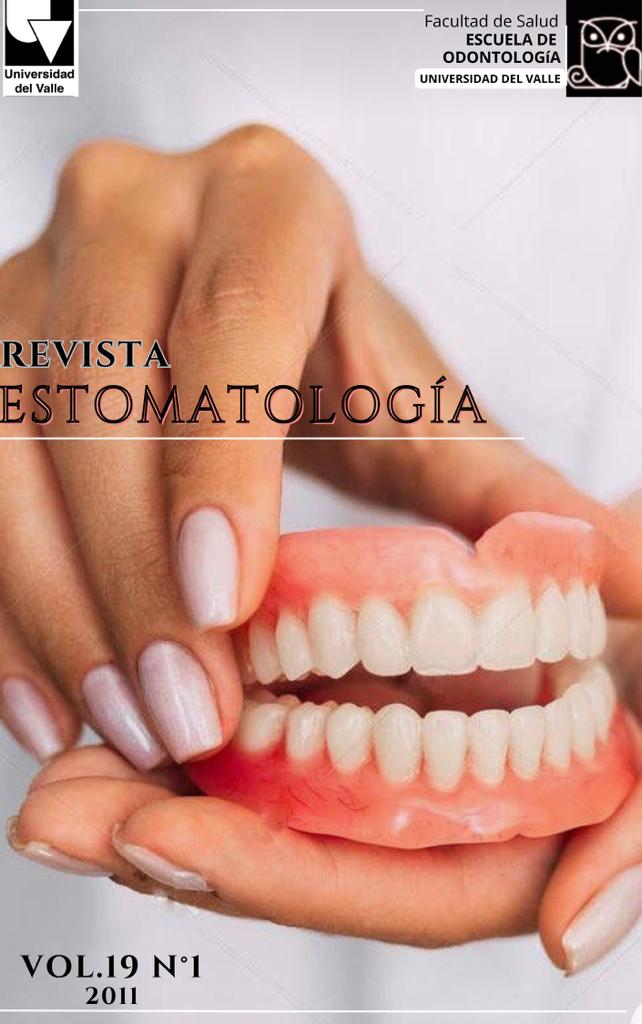Comparison of tensile properties of thermo cured acrylic resins for the preparation of denture bases
Main Article Content
SUMMARY
Objective: The purpose of this in vitro study
was to compare the tensile strength between
two materials for the manufacture of
acrylic denture bases (Veracril® from New
Stetic and SR Triplex Hot® from Ivoclar
Vivadent), and to know the mechanical
properties of materials to study that have
clinical implications.
Methods: Laboratory tests were conducted
under the technical standard of ASTM
International # D 638-03 to evaluate the
two acrylic resin materials for denture
bases, processed by pressed moulding. The
observations were made using the universal
testing machine Tinius Olsen® brand
H50KS to analyze the tensile properties
such as modulus of elasticity, elongation,
yield strength, maximum strength, energy,
effort and tensile stress between the two
materials evaluated.
Results: For the effort, maximum strength
and modulus of elasticity, high-impact
acrylic resin SR Triplex Hot® showed
higher values. With regard to the characteristics
of maximum displacement
before the fracture, elongation and energy,
conventional acrylic resin showed higher
values. The only characteristic that showed
a significant difference between the two
groups of thermo-cured acrylic resin was
the modulus of elasticity where the highimpact
acrylic resin obtained a much higher
value than conventional acrylic resin.
Conclusions: The acrylic resin SR Triplex
Hot® presents higher values in some tensile
properties, while the Veracril® shows
better in others. The only characteristic that
showed a significant difference between
the two acrylic resins was the modulus of
elasticity.
Keywords: Acrylic resin denture bases,
tensile strength, high impact acrylic resin.
- María Cecilia Osorio, Carlos Mejía, Olga Patricia Argote , Isabel Cristina Osorio, Alcira Viteri, Importancia del tratamiento integral precoz y regular en niños con malformación congénita de labio y/o paladar hendido , Revista Estomatología: Vol. 3 No. 2 (1993)
- Johana Moreno, Carlos Gutiérrez, Martha Rodríguez, Adriana Jaramillo, Prevalence of infection dissemination from odontogenic origin to the bucomaxilofacial complex , Revista Estomatología: Vol. 20 No. 1 (2012)
- Lorena Galvis, Natalia García, Bibiana Pazos, Maria Cristina Arango, Adriana Jaramillo, Comparation of caries detection in deciduous dentition with modified ICDAS index and dmf index in children from 1 to 5 years in Cali. , Revista Estomatología: Vol. 17 No. 1 (2009)
- Katya Botero Torres, Javier Enrique Bolero Torres, Martha Lucia Tello García , Adriana Jaramillo, Efecto de la quimioterapia sobre la microbiota subgingival y recuento de levaduras en saliva en pacientes de 6 a12 años con leucemia linfocítica aguda en el Hospital Universitario del Valle , Revista Estomatología: Vol. 11 No. 1 (2003)
- Aristides Baraya Martínez, Carlos Mejía Pavoni, Estudio del comportamiento de un dentífrico que contiene óxido de aluminio hidratado (alúmina) como sustancia abrasiva sobre el esmalte dental , Revista Estomatología: Vol. 1 No. 1 (1991)
- Carlos Mejía, Actualidades en anatomía: Nervio trigémino , Revista Estomatología: Vol. 1 No. 1 (1991)
- Carlos A. Mejía, Actualidades en anatomía: nervio maxilar I , Revista Estomatología: Vol. 2 No. 1 (1992)
- Carlos Mejía, Actualidades en anatomía: nervio mandibular, tronco anterior , Revista Estomatología: Vol. 3 No. 1 (1993)
- Carlos Mejía, Actualidades en anatomía: ganglio trigeminal , Revista Estomatología: Vol. 1 No. 2 (1991)
- Carlos A. Mejía, Actualidades en anatomía: nervio mandibular, tronco posterior , Revista Estomatología: Vol. 4 No. 1 (1994)
Los autores/as conservan los derechos de autor y ceden a la revista el derecho de la primera publicación, con el trabajo registrado con la licencia de atribución de Creative Commons, que permite a terceros utilizar lo publicado siempre que mencionen la autoría del trabajo y a la primera publicación en esta revista.





